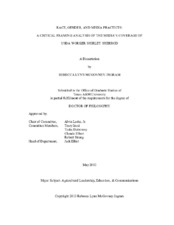| dc.description.abstract | On July 19, 2010, conservative blogger Andrew Breitbart posted a story on his website claiming USDA worker Shirley Sherrod was racist in her work with farmers. The edited video included with the story as proof, showed Sherrod speaking at an NAACP banquet. Sherrod was subsequently vilified in the media and fired from her job, only to be exonerated and rehired later that week.
Although the media claims their routine writing and reporting practices (such as newsworthiness, source selection, objectivity, and perpetual news cycle) make the industry better, researchers have shown that these practices lead to the use of shortcuts and stereotypes. This is especially detrimental to Black women because of the double-dose of stereotyping they are subject to when they are portrayed in the media.
The purpose of this study was to understand how media practices influenced the framing of race and gender in the media coverage of Sherrod. In order to integrate key elements of critical theory (i.e. activism, intersectionality, speaking position, subjectivity) I chose a mixed-methods approach for my framing analysis. This included open-ended reading of the news stories, constant comparative analysis of possible frames, quantitative coding sheet, analysis of statistics in SPSS, and inclusion of qualitative examples.
I analyzed a total of 93 news articles from 12 news sources for this study. Most of the news stories came from newer, online publications (n=67, 72.0%) and over half came from new sources with a liberal philosophy (n=47, 50.5%). I found three frames that were used to describe Sherrod in terms of race and gender: victim, good woman, and above her place. I also found that these frames were closely aligned with news values that help determine a story’s newsworthiness. I found seven sources were used repetitively and selectively associated with the frames. I also found differences in frames by news source type and philosophy. Finally, I found that the frames followed an identifiable news cycle.
The results of this study show that the media do indeed utilize negative stereotypes of Black women in their products and that media’s use of routine writing and reporting practices exacerbate this problem. | en |


